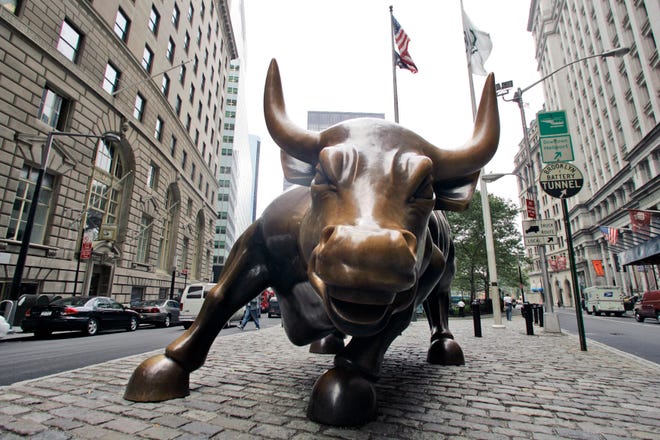
The S&P 500 index reached a milestone Thursday by marking a 20% rise from its most recent low and putting it in a bull market.
It’s a noteworthy achievement considering the obstacles stocks have faced, particularly the Federal Reserve’s aggressive interest rate hikes to fight inflation. Reaching that benchmark could also boost the morale of investors, leading to more stock buying and driving up share prices — along with the value of your 401(k).
But don’t pop the champagne just yet. The outlook for stocks and the economy is far from buoyant. And the market is still well below its prior peak.
What is a bull market?
A bull market is a period of rising stock prices. And those higher prices mean sizable profits for investors who own stocks.
The most common definition of a bull is a gain of 20% or more for the Standard & Poor’s 500 stock index from a prior low. The S&P 500 is used to measure these milestones because it holds 500 of the nation’s largest publicly traded stocks and is viewed as a good barometer of the overall market’s health.

When did the U.S. bull market start?
The current bull began on October 13, 2022, when the S&P 500 finally stopped falling and began drifting higher after closing at 3,577 the previous day. It’s now up 20% from that nadir after closing Friday at 4,298.86.
What is the best indicator for a bear market?
A bear market is when the S&P 500 suffers a 20% drop from a previous high. After peaking at 4,796 on January 3, 2022, the index tumbled 25.4% through October 12, forming a bear market. That decline was sparked by a historic inflation spike and the Fed’s efforts to tame the price surge by raising its key interest rate 5 percentage points in 14 months. Those developments have led economists to repeatedly predict that a recession would soon arrive.
What created the bull market?
The economy has defied high interest rates and inflation by continuing to grow because consumers flush with cash from pandemic-related savings and stimulus checks keep spending and employers are still hiring at a healthy clip. Inflation, meanwhile, remains high but has eased significantly after topping out at 9.1% a year ago. The Fed, in turn, is expected to pause its rate hikes at a meeting next week.
“The recession hasn’t come yet,” says Chris Zaccarelli, chief investment officer for Independent Advisor Alliance. “Because a recession hasn’t materialized people realize they were too (quick) to sell stocks.”
What is the significance of the bull market?
It means stocks have come a long way back from the bear market of 2022. If you had $10,000 in the market on January 3, 2022, that investment shrank to $7,460 on October 12. But thanks to the recent bull, your portfolio now sits at $8,952. That’s still 10.5% off the peak but better than being down 25.4%.
Also, when investors hear we’re in a bull market, it could spark others to jump in and buy stocks, further fueling a run-up in share prices.
“There’s definitely a psychological component,” Zaccarelli says. “It’s called momentum.”
He adds, “The bull market is all the more impressive because of the strong headwinds it has been fighting,” such as high interest rates, inflation and unrelenting recession forecasts.
Is it officially a bull market right now?
No entity calls a bull market in the way a non-profit group determines a recession. And some experts have different criteria for what constitutes a bull.
Howard Silverblatt, chief index analyst for S&P Dow Jones Indices, says the popular stock index won’t really be in a bull market until it rises above its January 2022 peak. Instead, he says, the current episode is a “bull run” within a bear market.
Teens see wages riseThat summer job before college? It comes with a raise. Teens cash in on hot labor market
How much will the stock market go up in 2023?
It’s hard to say if this bull market has legs or will soon peter out.
While the Fed is likely to pause its rate hikes next week, it’s probably not done raising them since inflation has been slow to come down. In fact, many forecasters expect the central bank to lift its benchmark rate again in July before halting it campaign of increases.
Also, banks have pulled back lending because of deposit runs that led to the collapse of several regional banks. Many economists still forecast a mild recession later this year because of the stricter lending, the delayed affects of the rate increases and the depletion of consumers’ excess cash.
If there’s a recession, stocks will probably head south again, Zaccarelli says.
Contributing: Adam Shell





